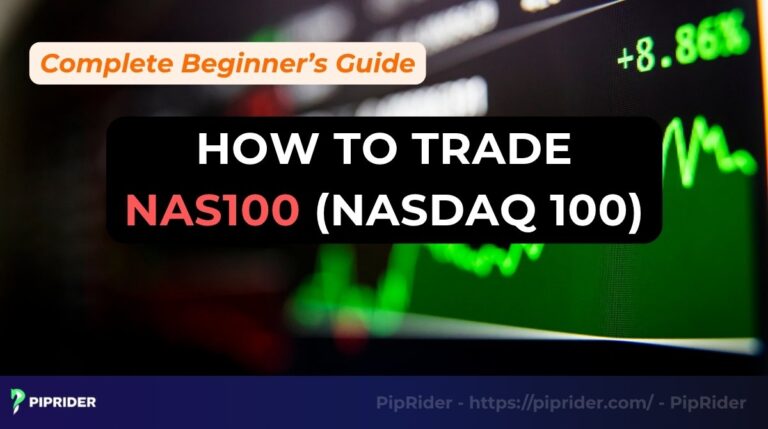Are you tired of endlessly flipping through dozens of charts, trying to find a currency pair that’s actually moving? The Currency Strength Indicator (also known as a Currency Strength Meter, CSM, or CS indicator) is a tool designed to solve this problem, giving you an instant, high-level overview of the entire Forex market in a single glance. It eliminates the guesswork and helps you focus your energy on the opportunities with the highest potential, adapting to diverse Market Conditions.
This guide will serve as your complete A-to-Z manual for the CSM, helping you make smarter Trading Decisions. We will cover what it is, how it works, and most importantly, how to use it in a powerful trading strategy to find the strongest trends every single day.
Key Takeaways
- The Currency Strength Meter isolates and grades individual currencies (USD, EUR, JPY, etc.) on a spectrum from most powerful to most vulnerable.
- This approach focuses on matching the most powerful currency against the most vulnerable one to identify high-momentum trends.
- A CSM instantly analyzes all 28 major and minor pairs, so you don’t have to do it manually.
- It helps you avoid flat, ranging markets by identifying currencies with similar strength.
- The CSM identifies which pairs to watch, but other forms of analysis are needed to determine the precise entry point.
1. What is a Currency Strength Meter?
A Currency Strength Meter is a technical tool that helps you analyze the Forex market from a different perspective. Instead of focusing on just one specific currency pair (e.g., EUR/USD), it allows you to view the entire market as a system of individual currencies (EBC, 2025). Every pair has a base currency and a quote currency, and the CSM analyzes them all.
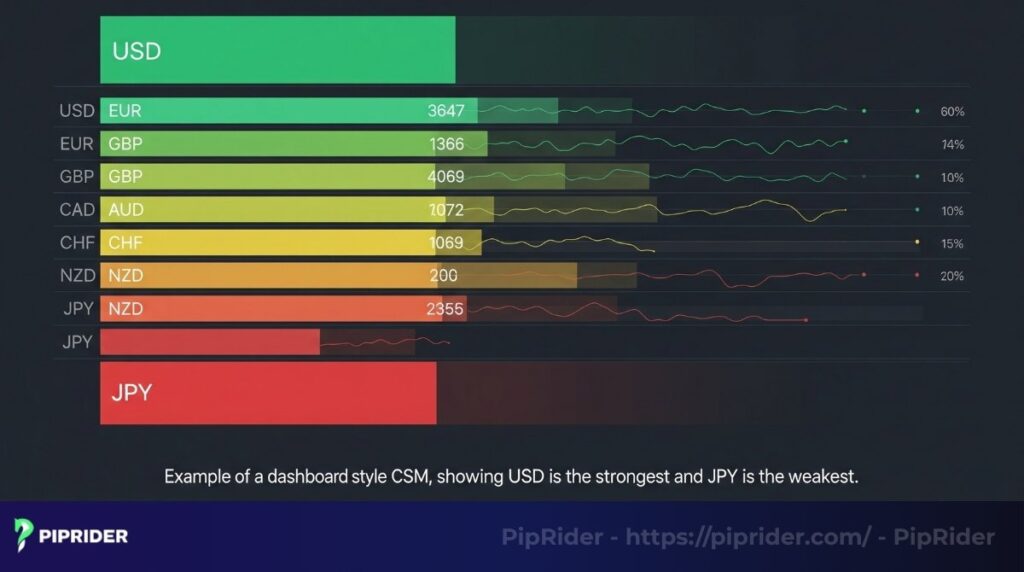
- Core definition: Imagine the Forex trading market as a sports league with 8 main teams (USD, EUR, JPY, etc.). A currency pair like EUR/USD is just one game. A Currency Strength Meter acts as the official league standings, grading each currency’s overall relative strength based on its collective performance. Each currency is given an average score based on its performance against all others.
- Main purpose: The main goal of the Currency Strength Meter is to instantly show you trend direction by indicating which currencies are getting stronger and which are getting weaker across the entire market. By analyzing the individual strength of each currency, you can more easily identify clear and powerful trends.
2. How does a Currency Strength Meter work?
While it might look simple on the surface, a good CSM runs a powerful algorithm in the background. It effectively automates the market-wide analysis that would take a human trader hours to perform manually.
2.1. The principle of operation
The Currency Strength Meter (CSM) operates by running a powerful algorithm designed to automate market-wide analysis. The core principle involves assessing the performance of individual currencies, rather than specific currency pairs, against the entire market. This effectively automates the analysis that would take a human trader hours to perform manually.
Illustrative Example:
To calculate the overall strength of a single currency, for example, USD, the algorithm analyzes the price change across all its related pairs (such as EUR/USD, USD/JPY, GBP/USD, and AUD/USD). It aggregates the performance data from these individual pairs to determine if USD, as a whole, is experiencing net buying or net selling pressure across the global market. This process is then repeated for all other major currencies (EUR, JPY, GBP, etc.).
2.2. How strength is displayed
Different tools visualize this data in a few common ways, each with its own benefits.
- Dashboard/gauge: Provides a quick, “at-a-glance” reading of the current market situation.
- Heatmap: Helps you visualize the relationships, or Forex pair correlations, between all pairs in a single grid.
- Chart: Line charts are our favorite. Plotting strength over time allows you to see not just who is strong now, but whose strength is accelerating or decelerating.
2.3. The importance of multiple timeframes
A professional CSM lets traders see strength in different timeframes. Analyzing multiple timeframes helps them identify the overall market direction and refine their execution. This is a vital practice in technical analysis because it addresses two major trading questions:
- Higher Timeframe (e.g., Daily or 4-Hour): This establishes the major trend and is used for trend identification. It tells the trader, “Which direction should I be trading?”
- Lower Timeframe (e.g., 1-Hour or 15-Minute): This refines the execution. It tells the trader, “When should I enter to get the best price?”
By observing price action across these different scales, a trader can ensure a short-term entry aligns with the larger market flow, significantly increasing the probability of success and leading to more informed trading decisions.
Example Scenario
For instance, you might see the JPY is the strongest on the Daily chart (a long-term trend) but the weakest on the 1-Hour chart (a short-term pullback). This context is crucial for timing your entry.
Read more:
- Unlock trades with Accumulation Distribution Indicator (A/D)
- Mastering the Accumulative Swing Index for better trades
3. Why do Forex traders need a CSM?
Incorporating a CSM into your routine isn’t just about adding another gadget; it’s about making your entire trading process more efficient and effective. It helps you focus on what truly matters, which is why a good currency strength indicator is a critical part of a trading system.
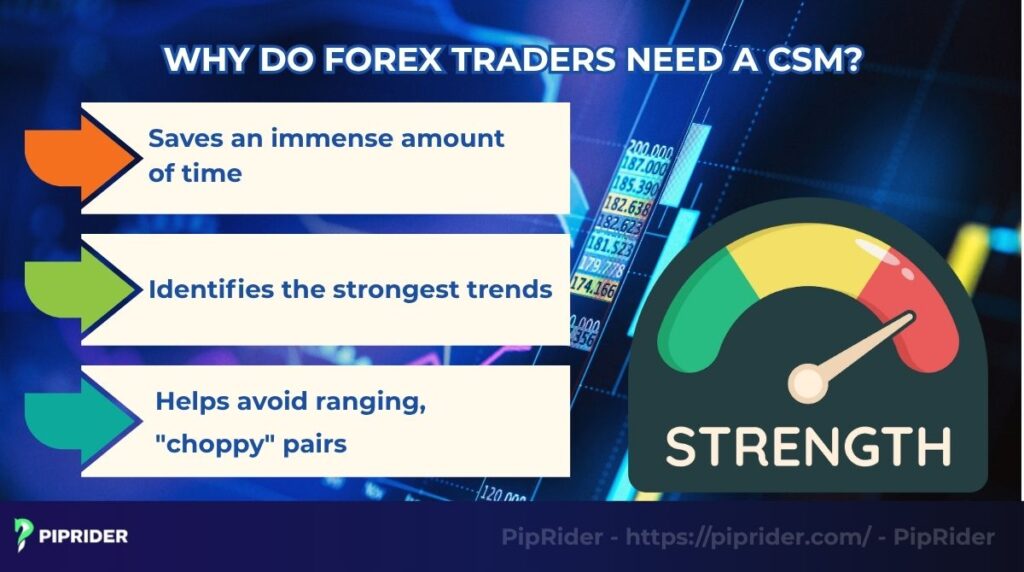
3.1. Saves an immense amount of time
The most obvious benefit is speed. Instead of manually clicking through 28 charts, a process that can take up to an hour, you look at one dashboard and get the same information in about five seconds. This frees up your mental energy for the more important task of analyzing the high-potential pairs.
3.2. Identifies the strongest trends
The market rewards traders who can find and ride strong trends. The CSM is designed specifically to find pairs where the strength divergence is greatest (e.g., the strongest currency vs. the weakest) (Day-Trade-Forex, n.d.). These are the pairs that will give you the cleanest charts and the most sustained moves.
3.3. Helps avoid ranging, “choppy” pairs
Just as crucially, a CSM signals which currency pairs should be ignored. When you see two currencies clustered together in the middle of the rankings, the corresponding pair (like EUR/GBP) is likely trapped in a range. These are capital traps, and learning to ignore them is a huge step forward for any trader.
4. A practical trading methodology using the CSM
This methodology uses the Currency Strength Meter (CSM) to implement a single, high-probability strategy: matching the strongest currency against the weakest currency. By trading these “push-pull” pairs, traders align their positions with the market’s most dominant money flow, leading to clear buy and sell signals.
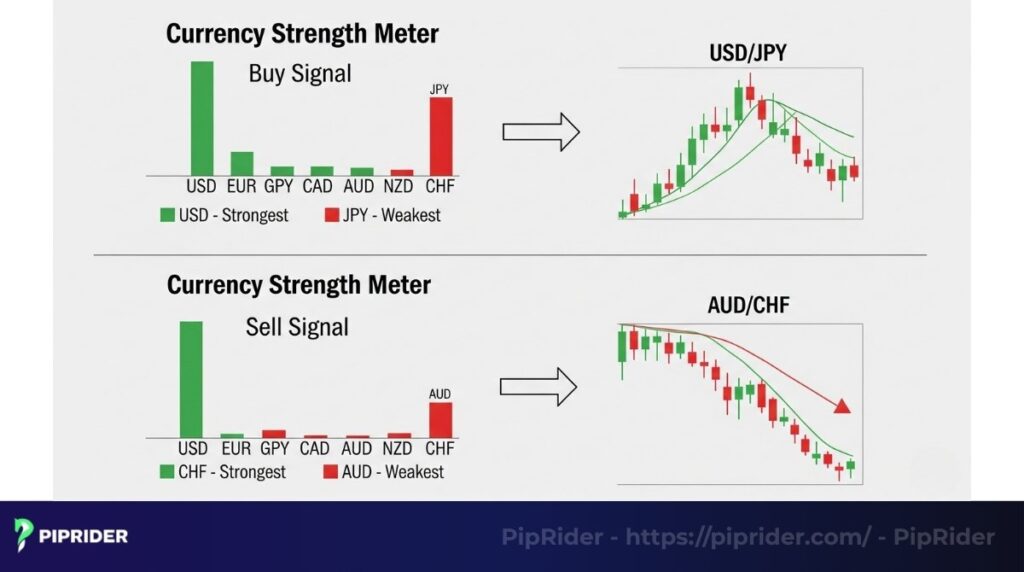
4.1. The foundational principle: Pit strength against weakness
The setups with the highest odds emerge when you match the currency experiencing widespread buying pressure against the currency facing widespread selling pressure. This creates a powerful “push-pull” dynamic on the chart, where one currency’s strength provides the fuel for the trend, while the other’s weakness ensures there is little opposition.
4.2. The buy signal (long trade)
The process is simple. First, you look at your CSM and identify the strongest currency (e.g., USD) and the weakest currency (e.g., JPY). The logical conclusion is to analyze the USD/JPY chart for a potential buying opportunity. You are aligning your trade with the market’s dominant money flow, which is often strongest for the base currency.
4.3. The sell signal (short trade)
Conversely, if the meter shows AUD to be the weakest base currency and CHF the strongest, the pair you should immediately analyze is AUD/CHF. Here, you are looking for a chance to sell the weak base currency (AUD) in exchange for a strong one (CHF).
5. Best currency pair selection: 3-step strength meter guide
The three-part methodology provides a straightforward, disciplined routine to implement at the beginning of each trading day, focusing your attention on the market’s most promising opportunities.
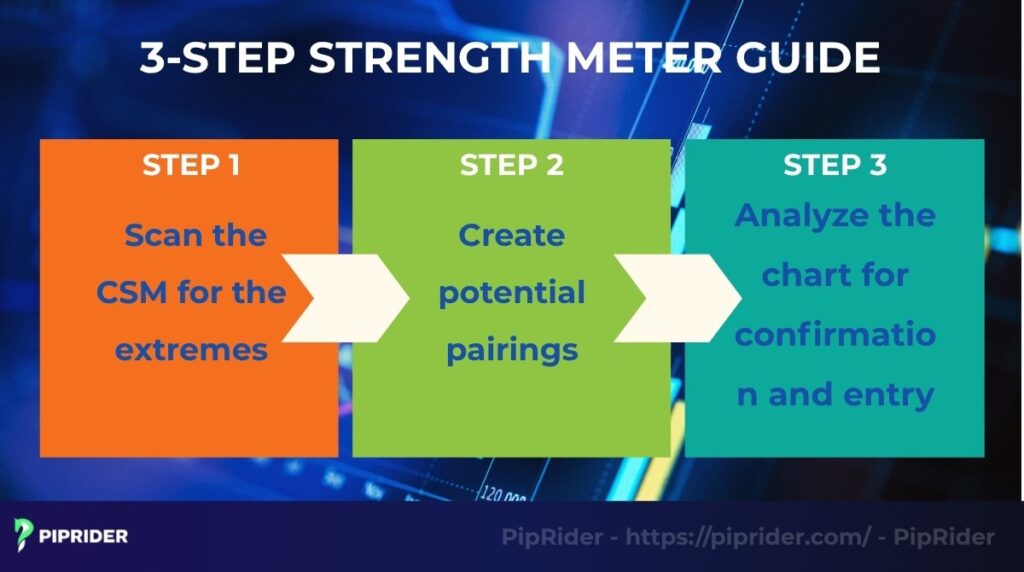
5.1. Step 1: Scan the CSM for the extremes
The very first step of our trading routine is to look at the CSM. We completely ignore the currencies in the middle of the pack. We are only looking for the outliers, the top one or two strongest and the bottom one or two weakest currencies.
5.2. Step 2: Create potential pairings
Once you have your extremes, you match them up to create a “watch list.” If USD is the strongest and JPY is the weakest, USD/JPY is our primary focus. If we see that CHF is the second strongest, CHF/JPY becomes our secondary pair to watch. This takes less than a minute.
5.3. Step 3: Analyze the chart for confirmation and entry
This is the crucial final step. The CSM has told you which chart to open. Now, you perform your actual technical analysis on that chart. You look for a clear trend, wait for a logical pullback to a support/resistance zone, and then look for a concrete entry trigger, like a pin bar or engulfing candle.
6. Combining CSM with other technical indicators
While the Currency Strength Meter is an elite-level filtering instrument, it doesn’t function as a self-contained trading methodology. Its insights become far more powerful and actionable when you pair them with classic technical indicators, forming comprehensive trading strategies.
6.1. CSM + Moving Averages
This is a classic trend-following combination. First, use the CSM to identify a strong/weak pair (e.g., you identify that you should be looking to buy GBP/JPY). Then, you open the GBP/JPY chart and wait for the price to pull back to a dynamic support level, like the 21-period EMA, before entering.
Benefit: This method ensures you are trading with the dominant trend while entering at a more logical, value-based price during a temporary dip, rather than chasing the top.
Example: The CSM shows GBP is $+7$ (Strongest) and JPY is $-5$ (Weakest). This confirms a strong uptrend on GBP/JPY. The trader waits for the price to drop back to the $21$-EMA (which is currently at $185.00$). Once the price touches $185.00$ and forms a bullish candle, a buy order is placed.
6.2. CSM + RSI/Stochastic
This combination is excellent for improving your entry price on an already identified trend. Let’s say the CSM confirms a strong downtrend on AUD/USD. Instead of selling immediately, you watch the RSI. When the price rallies briefly, causing the RSI to become overbought (e.g., above 70), you have a prime opportunity to short at a better price.
Benefit: This approach allows you to time your entry with greater precision, selling into short-term strength for a potentially better risk/reward ratio on your trade.
Example: The CSM shows AUD is $-8$ (Weakest) and USD is $+6$ (Strongest). This confirms a strong downtrend on AUD/USD. The trader watches the RSI. When the price makes a shallow rally to $0.6550$, the RSI hits $72$ (overbought). This RSI extreme is the perfect signal to enter a short (sell) position, anticipating the downtrend will resume.
The key principle:
Internalize this key difference: the CSM offers the high-level strategy (the what and why), while your other indicators provide the tactical trigger (the when). Here is a summary of these combined strategies:
| Combination | Purpose | Benefit |
| CSM + MA | To confirm a trend and find a dynamic support/resistance entry point. | Ensures you trade with the dominant trend and enter at a better, “value-based” price. |
| CSM + RSI/Stochastic | To time your entry with greater precision during an established trend. | Allows you to sell into short-term strength or buy into short-term weakness, improving your risk/reward ratio. |
7. How to choose the best Currency Strength Meter
One of the biggest points of failure isn’t the strategy itself, but the quality of the tool used to execute it. A slow or inaccurate CSM will consistently give you bad information. When evaluate a CSM, you should have a non-negotiable checklist to ensure it’s a professional-grade tool.
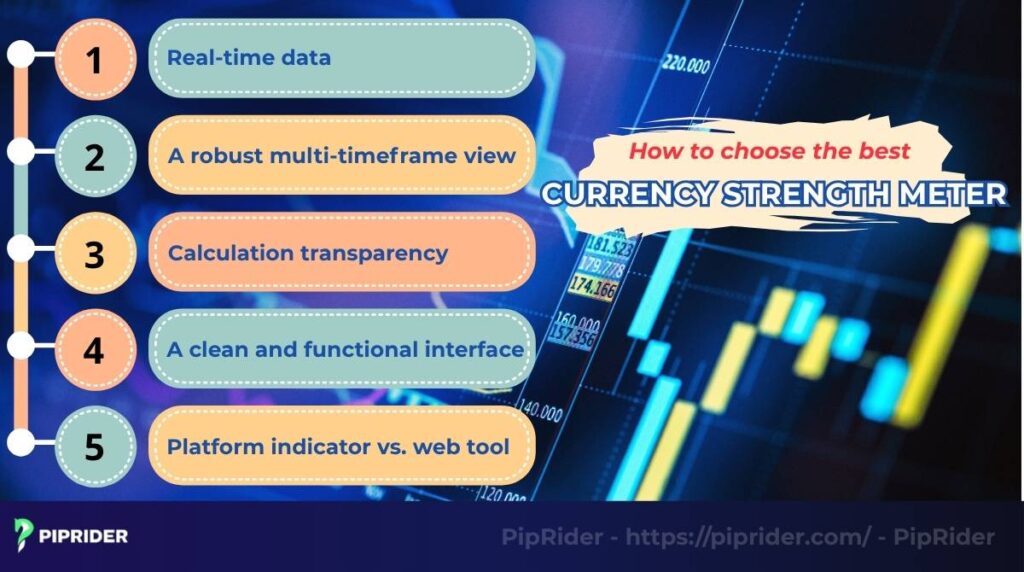
7.1. Real-time data
It is critical that the data refreshes from real-time exchange rates, with updates every few seconds at a minimum. While a five-minute data lag might be a minor issue for a long-term trader, for an intraday trader on the M5 chart, that same delay means the entire setup will have already passed. Accuracy requires speed.
7.2. A robust multi-timeframe view
A professional tool must allow you to see strength across multiple key timeframes (like M15, H1, H4, D1) on a single dashboard. This is critical for top-down analysis.
For example, seeing the USD is strong on both the D1 and H1 charts gives you high confidence to look for a buy. But if it’s strong on H1 and weak on D1, you know you are looking at a much riskier counter-trend move, indicating a higher risk level. This is especially true for risk currencies like the AUD or CAD, which can reverse quickly.
7.3. Calculation transparency
While you don’t need to know the complex math, a reputable provider should give you a general idea of how their strength is calculated. Do they use all 28 pairs? Is it based on weighted calculations or a Rate-of-Change formula?
A developer who is transparent about their methodology is generally more trustworthy than one who hides it behind a “secret formula.”
7.4. A clean and functional interface
The tool’s purpose is to provide clarity, not cause analysis paralysis. It should have a clean layout where you can instantly see the currency rankings without any distracting clutter. If you can’t interpret the data in under five seconds, the interface has failed.
7.5. Piprider’s recommendation: Platform indicator vs. web tool
Generally, CSM tools come in two main flavors: web-based tools and indicators you install on MT4 vs MT5. Web tools are convenient, but a high-quality indicator installed directly on your trading platforms is almost always superior.
It pulls data directly from your broker’s price feed, ensuring maximum speed and accuracy, and it’s integrated right into your trading platform’s charting workflow.
8. Frequently asked questions (FAQs)
9. Conclusion
The Currency Strength Meter (CSM) is an indispensable tool for modern Forex traders. It automates analysis, saving time, and forces focus onto currency pairs with the highest potential for a strong trend. By pitting the strongest currency against the weakest, traders make data-driven decisions, improving their trading decisions and offering options for hedging.
Ready to stop wasting time? Find a reliable CSM and start applying this powerful strategy on a demo account today. Follow Piprider to learn more about the best technical indicators and other useful tools in trading today.








